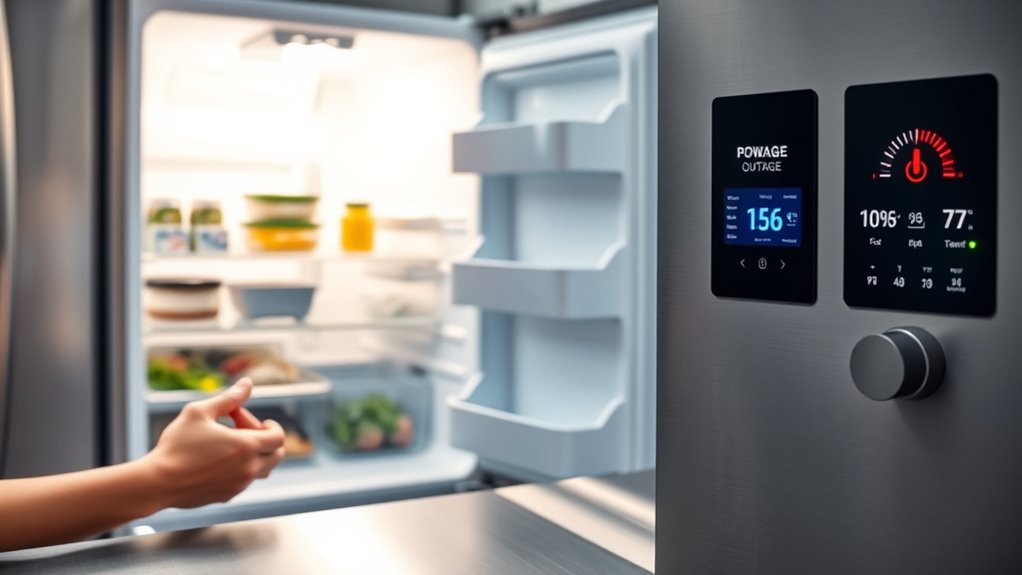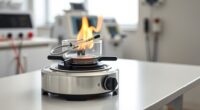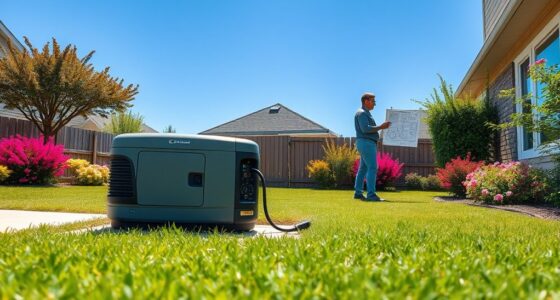During a power outage, it’s important to keep your refrigerator door closed as much as possible and monitor how long the power has been out. Use a thermometer to check food temperatures regularly and know when to discard perishable items that have been in the danger zone (40°F–140°F) for over 2 hours. Keep frozen foods frozen, cover your food to prevent contamination, and properly thaw items. If you’re unsure, it’s safer to throw food away—follow these vital rules to stay safe.
Key Takeaways
- Keep refrigerator and freezer doors closed to maintain cold temperatures and prevent spoilage during power outages.
- Use a thermometer to monitor food and appliance temperatures, discarding perishable items if above safe thresholds for over 2 hours.
- Employ emergency ice or gel packs to extend cold retention and organize food to minimize waste and contamination risks.
- Avoid re-freezing foods that have been above 40°F for more than 2 hours to prevent bacteria growth.
- Properly handle, cover, and label foods to prevent cross-contamination and ensure safety during storage and handling.
Keep the Refrigerator Door Closed as Much as Possible
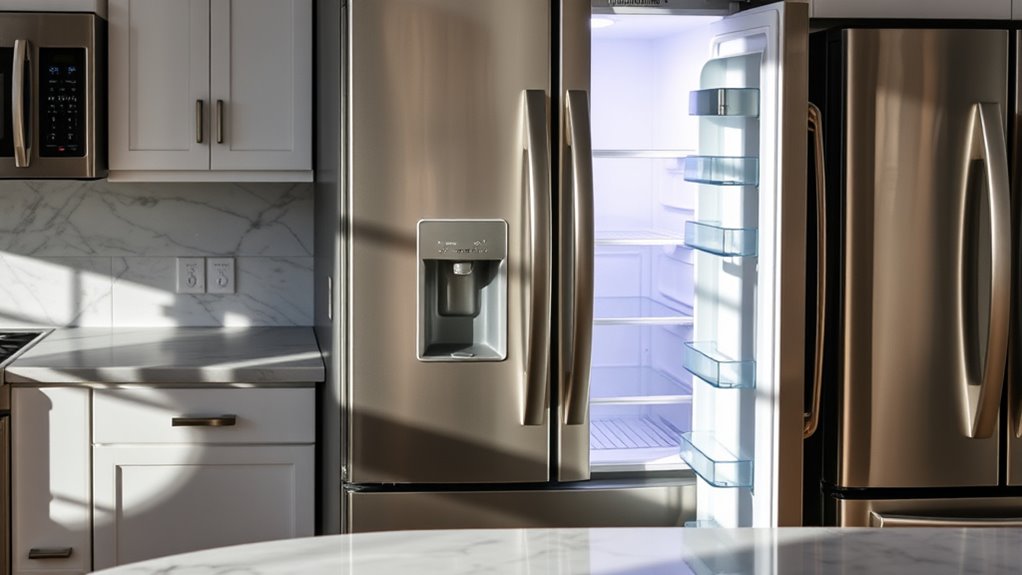
During a power outage, every moment the refrigerator door remains open allows cold air to escape, which raises the temperature inside. To keep food safe, maintain good refrigerator organization so you can quickly find what you need without rummaging. This minimizes how often you open the door. Additionally, check your door seal regularly to ensure it’s airtight; a faulty seal lets cold air escape even when closed. When you do open the door, do it swiftly and close it immediately afterward. Each unnecessary opening shortens the time your fridge stays cold, risking spoilage. Keeping the refrigerator well-organized and the door seal in top shape helps preserve the cold temperature longer, protecting your food during outages. Incorporating temperature regulation techniques can further help maintain optimal conditions inside your fridge.
Determine How Long Your Power Has Been Out
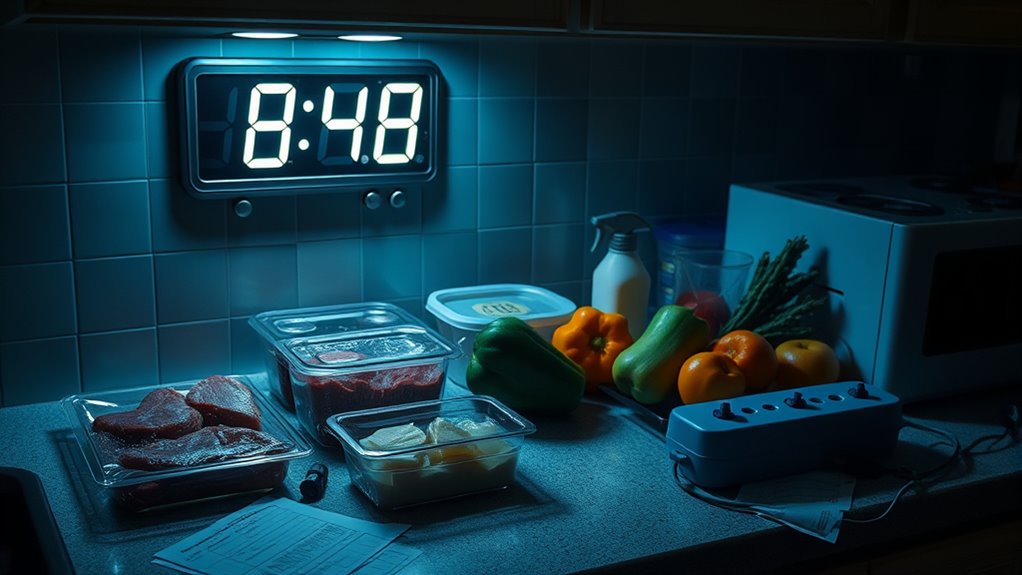
To keep your food safe, you need to know how long the power has been out. Check the clock or use a timer to track the duration, and note the outage start time. This information helps you decide whether your food is still safe to consume. Monitoring skin hydration levels can also inform you about potential effects on perishable foods during prolonged outages.
Check Power Duration
How long has your power been out? Determining the duration is essential for food safety and emergency communication. The longer the outage, the higher the risk of spoiled food. Use a clock or timer to track the start time and note when power is restored. If you’re unsure, check for signs like melted ice or warm refrigerators. Remember, your power outage preparedness isn’t complete without knowing how long you’ve been offline. Here’s a quick guide:
| Duration of Power Outage | Food Safety Implication |
|---|---|
| Less than 4 hours | Food remains safe in fridge |
| 4-24 hours | Check temperature, discard perishable if warm |
| Over 24 hours | When in doubt, throw it out |
| After power returns | Reassess stored food safety |
Stay connected through emergency communication and act promptly. Regularly monitoring your food safety during an outage helps prevent foodborne illnesses.
Use Timer or Clock
Keeping track of how long your power has been out is essential for food safety. Using a digital timer or an analog clock helps you monitor the duration accurately. This is vital because perishable foods can spoil if left in the danger zone for too long. Automation technologies can assist in monitoring and alerting you when safe limits are exceeded.
To stay informed:
- Set a digital timer or note the time on your analog clock immediately when the power goes out.
- Regularly check the timer or clock to stay aware of elapsed time.
- Use this information to decide whether food is safe to keep or needs discarding.
Track Outage Start Time
When the power goes out, it’s essential to determine exactly when it happened so you can assess how long perishable foods have been in the danger zone. Tracking outage duration helps you estimate how long your food has been at risky temperatures, guiding safe disposal or consumption. To do this effectively, record the outage start time immediately with a clock or timer. Use the table below to log your observations:
| Event | Time |
|---|---|
| Power outage begins | [Insert time] |
| Power restored | [Insert time] |
| Duration of outage | [Calculate duration] |
| Notes | [Additional details] |
Accurate power loss estimation allows you to make informed decisions about food safety, minimizing waste and health risks. Being aware of power outage duration also helps you understand the potential impact on your home’s water quality, especially if you rely on well water or filtration systems that may be affected during extended outages.
Use a Thermometer to Check Food Temperatures Regularly
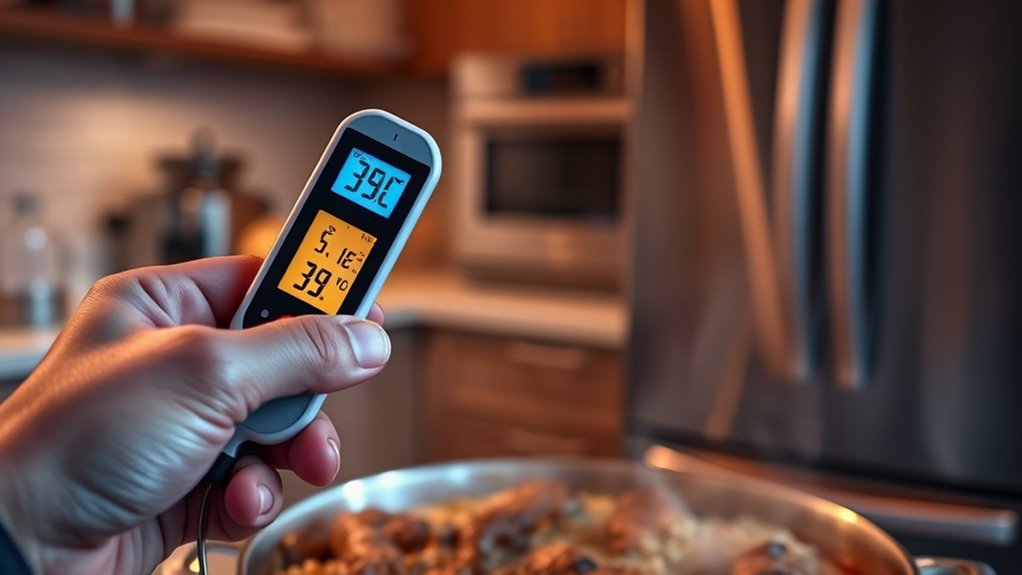
Using a thermometer to check food temperatures regularly is essential for ensuring safety during a power outage. Proper temperature monitoring helps you determine if food remains safe to eat or needs disposal. Keep your food thermometers handy and check temperatures at least every few hours. This practice prevents consuming spoiled food and reduces waste. Maintaining accurate readings is crucial; calibration ensures your thermometer provides reliable measurements over time. Here are three key points for effective temperature monitoring: 1. Ensure your food thermometers are accurate and calibrated before use. 2. Regularly check the internal temperature of perishable items, aiming for below 40°F or above 140°F. 3. Record temperature readings to track potential spoilage over time.
Know When to Discard Perishable Items
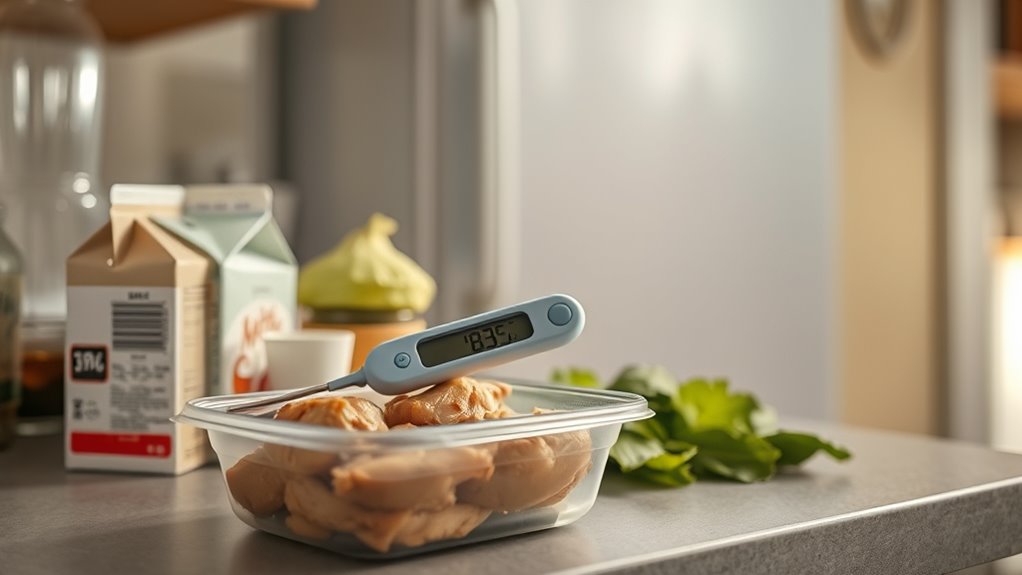
You need to be aware of the temperature danger zone, which is between 40°F and 140°F, where bacteria grow quickly. Perishable foods should be discarded if they’ve been in this range for more than two hours, or one hour if it’s hot outside. Staying vigilant guarantees you avoid risking foodborne illness. Remember, proper storage and handling are essential to food safety during power outages.
Temperature Danger Zone
Ever wondered how long perishable foods can stay safe during a power outage? The key is understanding the Temperature Danger Zone, which is between 40°F and 140°F. Within this range, bacteria multiply rapidly, increasing food spoilage risk. To prevent unsafe consumption, focus on temperature management. Here are three critical points:
- Keep refrigerator and freezer doors closed as much as possible to maintain cold temperatures.
- Use a thermometer to monitor internal temperatures regularly.
- Discard any perishable item that has been in the danger zone for more than 2 hours.
- Regularly checking the air quality inside your refrigerator can help ensure optimal cooling performance and prevent spoilage.
Time Limit for Storage
During a power outage, perishable foods can only be safely stored for a limited amount of time before bacteria grow to dangerous levels. Generally, perishable items in your refrigerator should be discarded after four hours without power, especially if temperatures rise above 40°F. Proper refrigerator maintenance guarantees your unit keeps food safe longer when power is restored, but during outages, you must rely on time limits. Planning ahead is key—know which foods are most vulnerable and keep a thermometer handy. If food has been above safe temperatures for more than two hours, it’s best to discard it. Regular power outage planning, including knowing when to toss perishable items, helps prevent foodborne illnesses and keeps your household safe. Additionally, understanding Porsche Tuning options can be crucial if you rely on your vehicle for emergency supplies or transportation during outages.
Keep Frozen Food Frozen When Power Is Restored Quickly
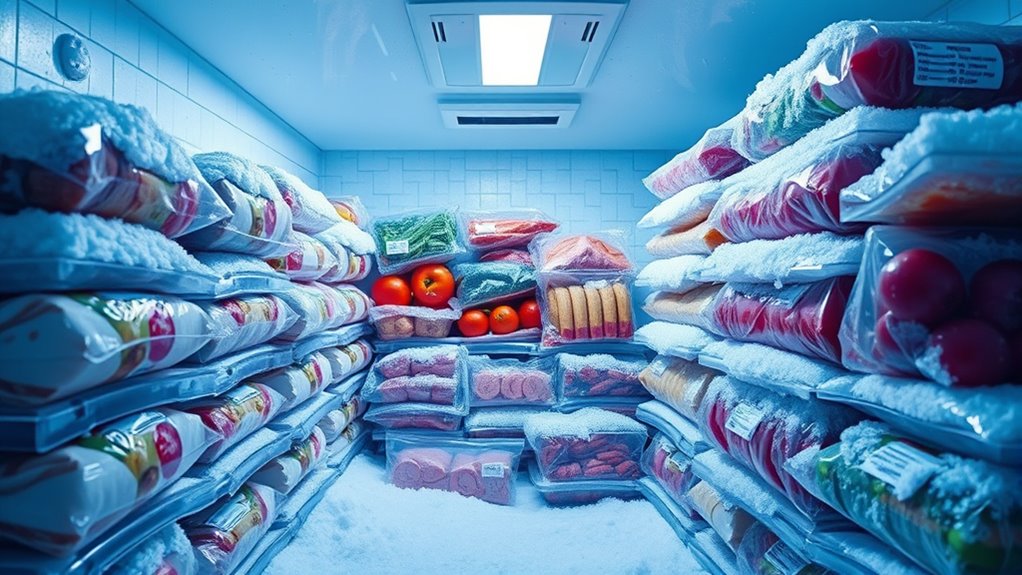
When power is restored quickly, it’s crucial to keep frozen food frozen to prevent spoilage. Rapid restoration helps maintain the food temperature, but you must act fast. Use ice packs around your frozen items to keep them cold longer. Avoid opening the freezer unnecessarily, which lets warm air in. Here are three key tips:
Keep frozen food safe after power outages by using ice packs, closing the freezer, and checking temperatures promptly.
- Place ice packs on top of frozen food to reinforce the cold barrier.
- Keep the freezer door closed to retain low temperatures.
- Check food temperature; if it stays below 40°F, food remains safe.
- Consider using automation tools to monitor freezer temperatures remotely and receive alerts if temperatures rise.
Store Emergency Ice or Frozen Gel Packs in the Freezer
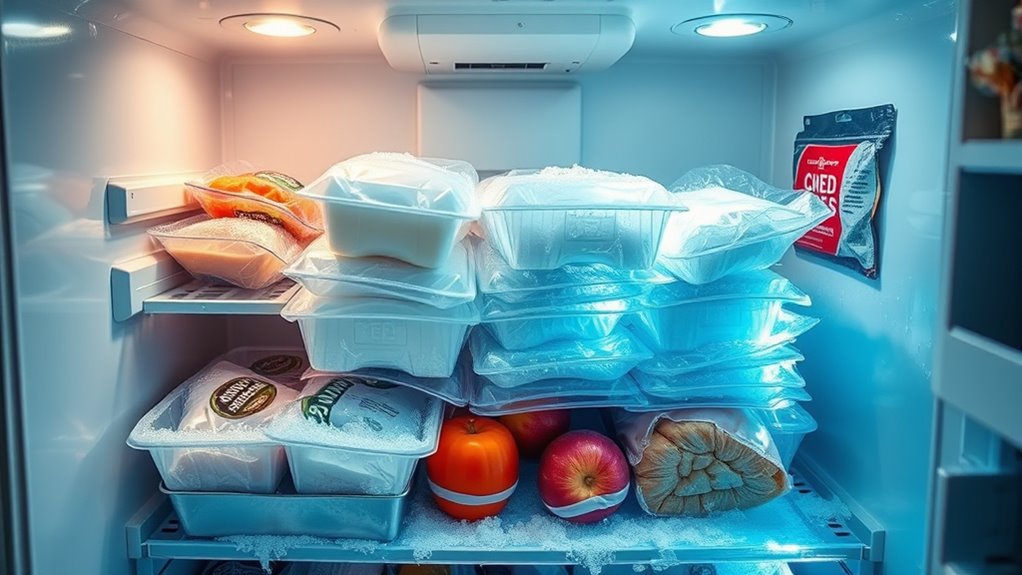
You should freeze emergency ice or gel packs before a power outage to keep them prepared. Using these packs helps preserve your food longer and can replace regular ice when needed. Storing them in your freezer ensures they’re on hand when a power loss occurs.
Freeze Before Power Outage
To guarantee your freezer stays cold longer during a power outage, it’s smart to prepare by freezing emergency ice or gel packs in advance. Proper freezing techniques are essential for effective food preservation and extending cold retention. By doing this early, you ensure your emergency supplies are ready when needed.
Consider these tips:
- Use airtight containers or freezer bags to prevent freezer burn.
- Freeze packs flat for faster freezing and easier stacking.
- Place gel packs at the top or around perishable items for maximum cooling.
These steps enhance food preservation and maximize your freezer’s ability to stay cold longer. Preparing in advance helps maintain safe temperatures, protecting your food during unexpected outages.
Use for Food Preservation
Storing emergency ice or frozen gel packs in the freezer is essential for effective food preservation during power outages. These packs help keep perishable foods cold longer, preventing spoilage. Use them to maintain a safe temperature in your fridge and freezer, especially when combined with techniques like food dehydration and salt curing. Food dehydration removes moisture, slowing bacteria growth, while salt curing draws out moisture and preserves meats and other foods. Keep the gel packs organized in your freezer to maximize cooling efficiency. When the power goes out, place them around vulnerable items to maintain a cold environment. Proper storage of these packs ensures your food remains safe and reduces waste, giving you more options to preserve your supplies until power is restored.
Replace Regular Ice
Replacing regular ice with emergency ice or frozen gel packs can considerably improve your food preservation efforts during a power outage. These alternatives last longer and help maintain a colder temperature in your freezer, aiding in ice replenishment. To maximize their effectiveness, store emergency supplies like gel packs or ice in the freezer ahead of time. This guarantees quick access when needed, reducing spoilage risks.
Here are three key points to contemplate:
- Keep emergency ice or gel packs frozen at all times for immediate use.
- Use them strategically around perishable foods to extend freshness.
- Rotate your emergency supplies regularly to prevent thawing and ensure availability during outages.
This approach helps you protect your food and reduce waste during unexpected power loss.
Avoid Re-Freezing Thawed Food That Has Been Above 40°F
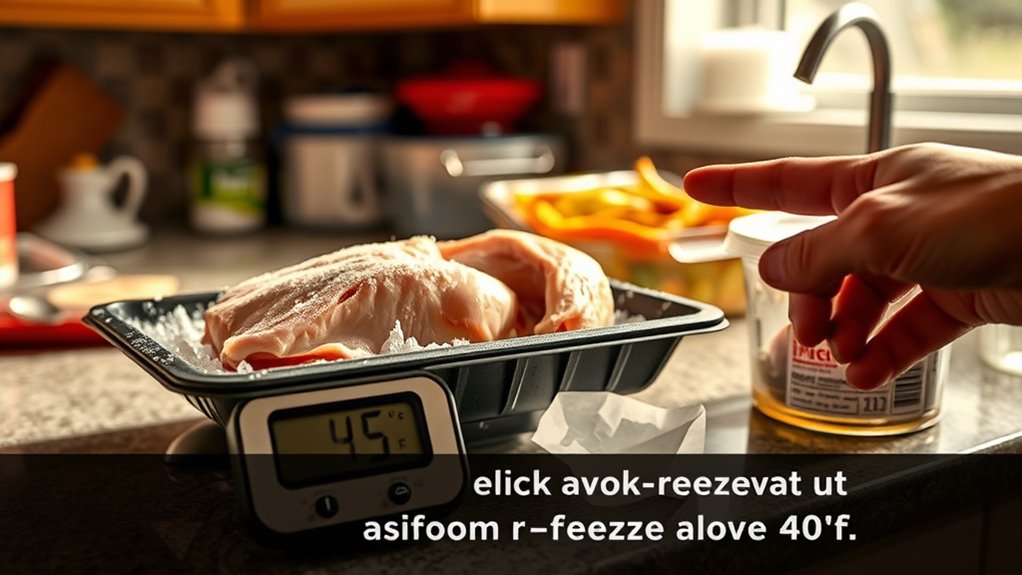
Re-freezing food that has been above 40°F for an extended period can pose serious health risks. When food thaws above this temperature, bacteria can grow rapidly, increasing the chance of foodborne illness. Re freezing caution is essential; refreezing thawed food that’s been at unsafe temperatures doesn’t kill bacteria, it allows them to multiply. Thawed food safety depends on how long the food stays above 40°F. If it’s been over two hours, especially in warm conditions, discard it. Avoid the temptation to re-freeze just because the food looks and smells okay. Proper handling is key to preventing illness. Remember, once food has been above the safe temperature range for too long, re-freezing can do more harm than good. Always prioritize safety over saving spoiled food.
Prioritize Eating or Preserving Perishable Items First
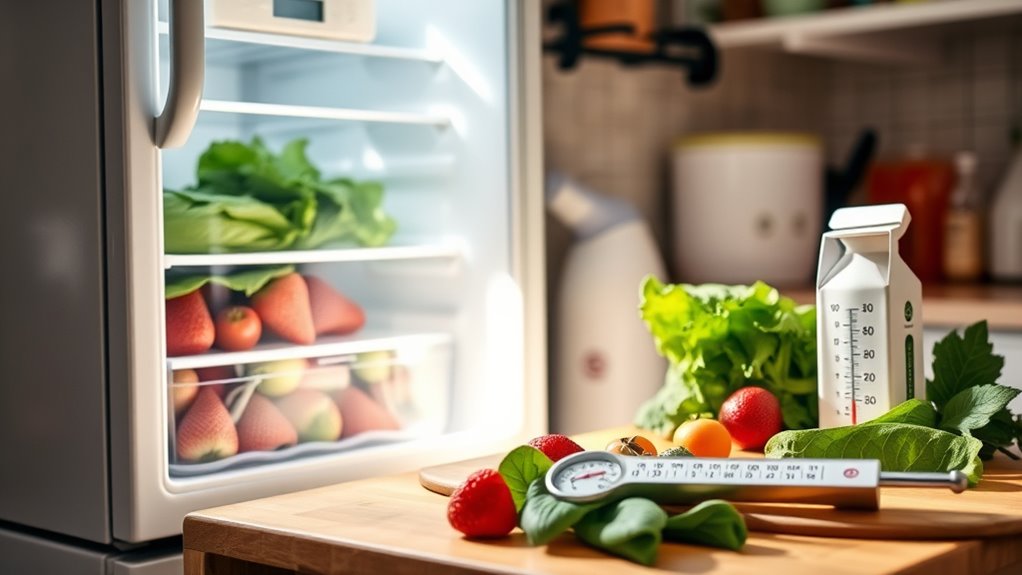
You should focus on eating or preserving perishable items before they spoil. Use your cold storage first to keep foods safe longer, and prioritize consuming items that are more vulnerable to bacteria. Acting quickly can prevent waste and keep your food safe during a power outage.
Consume Before Spoilage
When power is lost, perishable foods like dairy, meats, and fresh produce can spoil quickly, so it’s crucial to prioritize eating or preserving these items first. Food expiration dates and spoilage indicators can help you determine what to consume immediately. Look for signs like sour smells, slimy textures, or discoloration. To avoid waste, follow these steps:
- Consume items that show clear spoilage indicators first.
- Focus on perishables nearing their food expiration date.
- Use or preserve foods with minimal spoilage signs to prevent unnecessary waste.
Act quickly to prevent spoilage, as bacteria multiply fast without refrigeration. Prioritizing these foods ensures safety and minimizes waste during power outages.
Use Cold Storage First
Since power outages disable refrigeration, it’s essential to use your cold storage options first to keep perishable foods safe. Prioritize eating or preserving items that depend on cold storage for food preservation. Check your refrigerator and freezer, consuming or preserving perishable foods before they spoil. Use the table below to identify what to eat first:
| Food Item | Priority |
|---|---|
| Dairy products | Eat immediately |
| Fresh meats & seafood | Consume quickly |
| Cooked leftovers | Use within 24 hours |
| Fresh produce | Consume soon |
| Frozen foods | Keep in freezer if possible |
This approach minimizes food waste and keeps your food safe longer during a power outage. Remember, cold storage is your first line of defense for food preservation.
Use a Cooler With Ice for Items That Need Immediate Attention
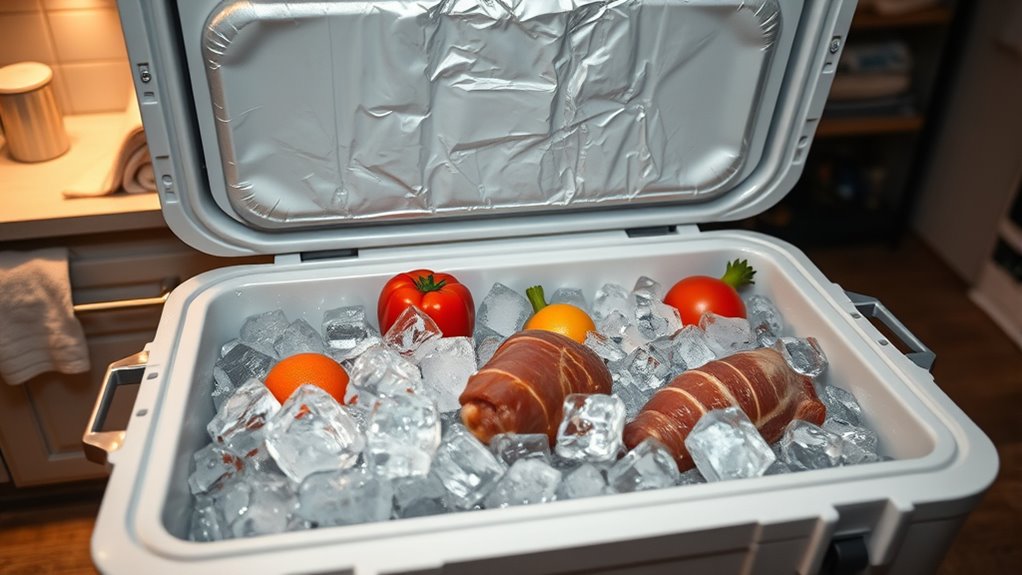
During a power outage, immediate action can help prevent food spoilage. Using a cooler with ice is essential for items that need quick preservation. Proper ice storage keeps food cold and prevents bacteria growth. Organize your cooler so perishables are on top and surrounded by ice, ensuring even cooling.
Consider these tips:
- Prioritize which foods need immediate attention and pack those first.
- Keep the cooler tightly sealed to maintain low temperatures longer.
- Regularly check and replenish ice to sustain a safe environment.
Efficient cooler organization minimizes temperature fluctuations and maximizes ice use, protecting your perishable foods. Acting swiftly with these steps ensures your food remains safe until power is restored.
Understand Which Foods Can Be Safely Cooked or Canned

Knowing which foods can be safely cooked or canned after a power outage helps you make the most of your preserved supplies. Focus on foods that are still safe based on their storage time and condition. Generally, canned vegetables, fruits, and meats are good options if they haven’t been compromised. Use the table below to visualize safe choices:
| Food Type | Safe to Cook/Canned? | Notes |
|---|---|---|
| Canned Goods | Yes, if intact and properly stored | Check for bulging or leaks |
| Frozen Items | Yes, if still frozen or cold | Consume promptly |
| Fresh Meat | No, unless refrigerated properly | Risk of bacteria growth |
Prioritize food safety and emergency preparedness by selecting foods that can be safely cooked or canned during power loss, reducing waste and health risks.
Avoid Cross-Contamination During Cleanup and Handling
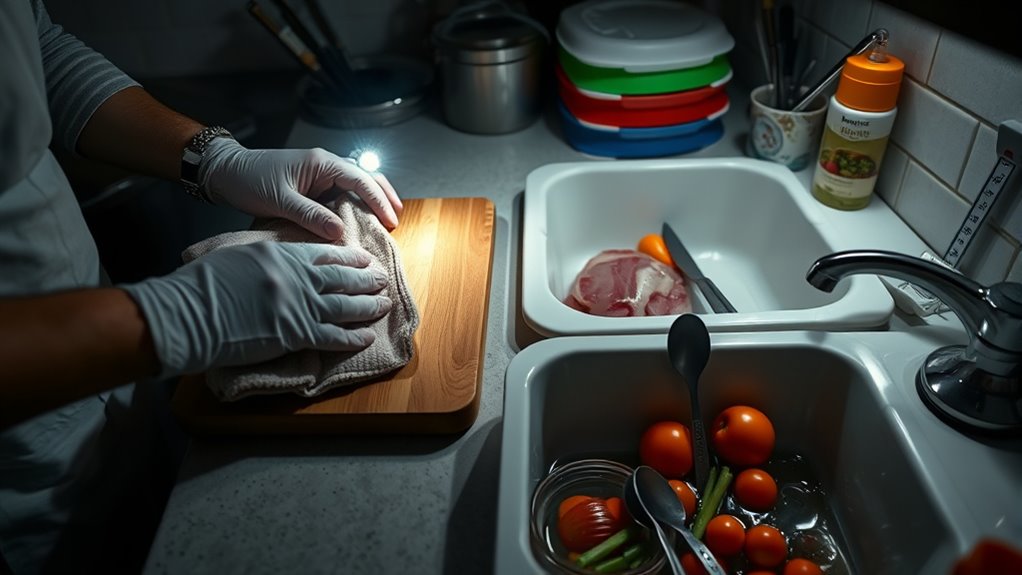
To prevent the spread of bacteria and foodborne illnesses, it’s essential to avoid cross-contamination during cleanup and handling. Proper kitchen sanitation is key—use separate cutting boards and utensils for raw meats and produce. Always wash your hands thoroughly before handling different foods, and clean surfaces regularly. Food labeling helps you identify safe zones for each item, reducing mix-ups.
Here are three tips to improve safety:
- Use color-coded cutting boards for raw meats, vegetables, and cooked foods.
- Sanitize countertops and utensils after each use, especially when switching between food types.
- Clearly label stored foods to prevent accidental cross-contact.
Following these steps minimizes risks and keeps your food safe during power outages.
Be Wary of Canned and Packaged Goods With Damage or Swelling
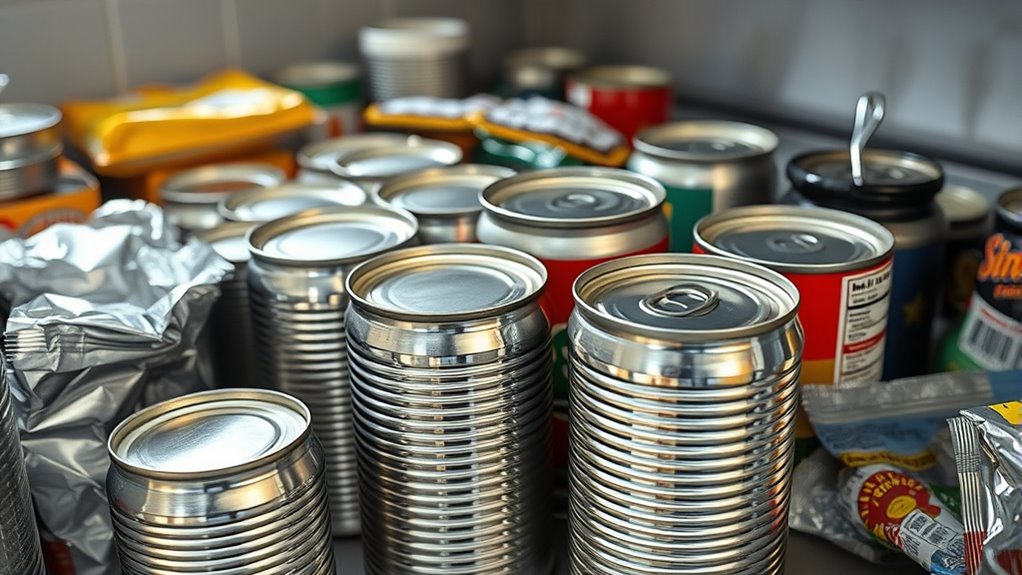
Canned and packaged foods with damage or swelling should never be consumed, as they can harbor harmful bacteria or toxins. Canned damage, such as dents, cracks, or leaks, compromises the integrity of the container, allowing bacteria to enter. Swelling packaging is a clear sign of bacterial activity producing gas inside the can, making it unsafe. Do not open or taste foods from damaged or swollen cans, as they may cause illness. Always inspect cans and packages before use, discarding any with bulges, leaks, or corrosion. Power outages can increase the risk of bacteria growth in compromised packaging, so err on the side of caution. Properly dispose of damaged goods to prevent accidental consumption and protect your health during emergencies.
Keep Food Covered to Prevent Contamination
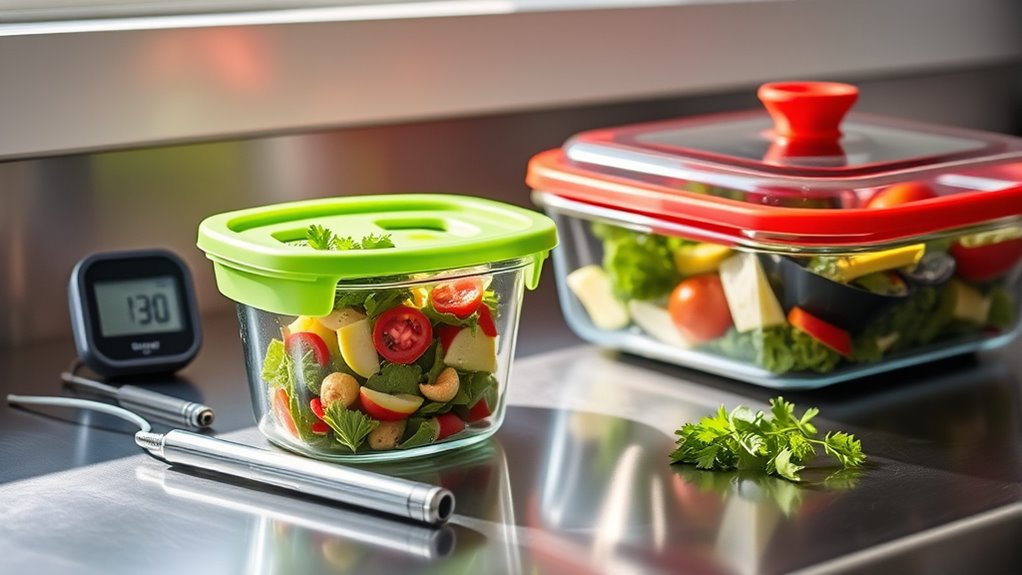
Damaged or swollen cans and packages can already pose a risk of contamination, so it’s important to take extra precautions during a power outage. Keeping food covered helps maintain cover hygiene and prevents airborne contaminants from settling on your food. It also shields food from dust, pests, and other potential sources of germs. Properly covered containers make it easier to identify food through accurate food labeling, reducing accidental mix-ups.
To ensure safety, remember:
- Use airtight containers or tightly seal food to block out contaminants.
- Cover leftovers and perishable items with clean lids or wraps.
- Keep food in covered containers when stored, especially in coolers or refrigerators, to maintain hygiene and prevent contamination.
Properly Thaw Frozen Food to Prevent Bacterial Growth
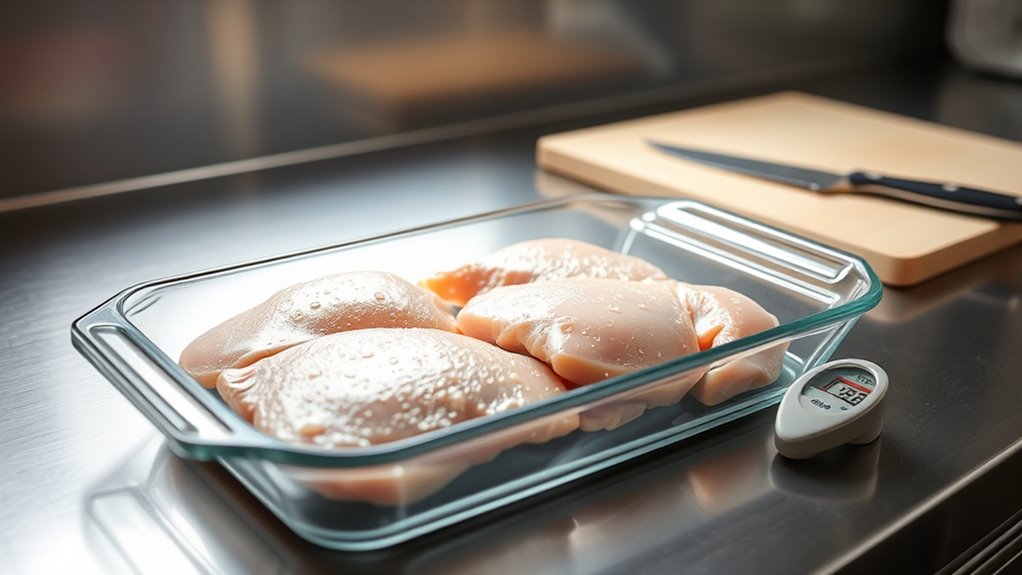
When thawing frozen food during a power outage, it’s essential to do so safely to prevent bacterial growth. Use proper thawing techniques like placing food in the refrigerator if power is restored soon, or submerging it in cold water in a leak-proof bag if you need a quicker method. Never thaw food at room temperature, as this encourages bacteria to multiply rapidly. Bacterial growth accelerates when food stays in the temperature danger zone (40°F to 140°F) for too long. Keep frozen items in a cooler with ice packs if possible, and plan ahead to thaw foods safely. By following these thawing techniques, you reduce the risk of foodborne illness caused by bacterial growth during power outages.
When in Doubt, Throw It Out to Protect Your Family’s Health
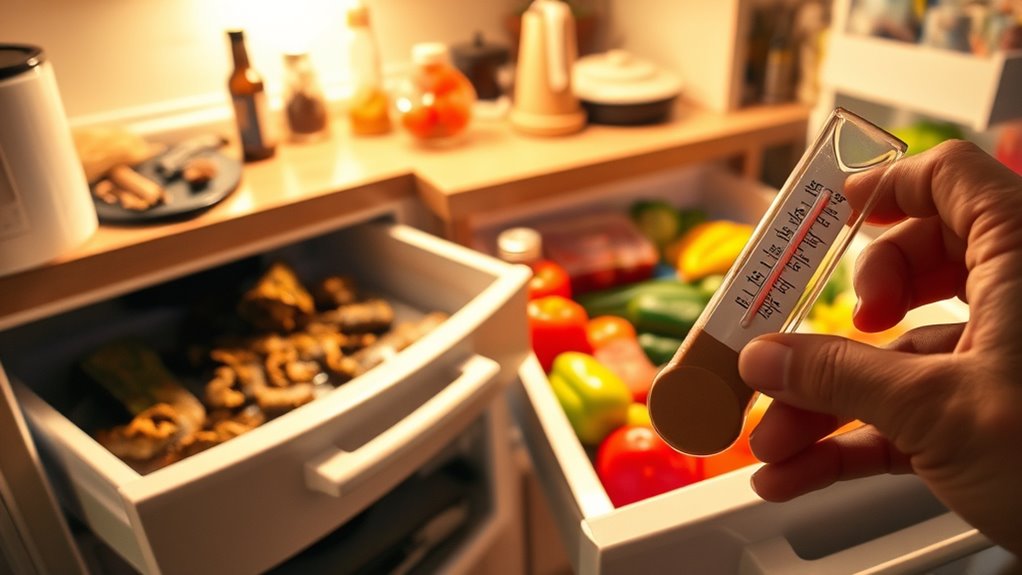
If you’re unsure whether food is safe after a power outage, it’s best to err on the side of caution and throw it out. Relying on food safety myths can lead to risky decisions. Remember, bacteria can grow quickly when perishable foods sit above 40°F for more than two hours. To avoid illness, follow these principles:
When unsure after a power outage, discard perishable foods sitting above 40°F for over two hours to prevent illness.
- Discard any food with an unusual odor, color, or texture—even if it looks fine.
- Prioritize emergency meal planning by stocking non-perishable items.
- When in doubt, throw it out to keep your family safe from foodborne illnesses.
Frequently Asked Questions
How Can I Tell if My Freezer Has Lost Its Cold Enough?
You can tell if your freezer has lost its cold enough by checking the temperature monitoring device or thermometer inside. Aim for 0°F (-18°C) or lower. Also, inspect the appliance for any signs of malfunction, like inconsistent cooling or strange noises. If the temperature rises above 40°F (4°C), food safety is compromised, so take action immediately. Regular appliance inspections help prevent unexpected temperature spikes.
What Signs Indicate Food Has Been Unsafe After a Power Outage?
If your food shows signs of spoilage like an off smell, discoloration, or slimy texture, it’s unsafe to eat. Check for bacteria growth indicators such as bubbles, foul odor, or mold. If the food has been above 40°F for more than two hours, bacteria can multiply quickly, increasing the risk of illness. When in doubt, discard questionable items to avoid foodborne illnesses.
Are There Specific Foods That Are Safer to Reheat After Power Is Restored?
Imagine you’re reheating leftovers after a power outage. Stick to safe reheatable foods like cooked meats and fully cooked casseroles, following proper food reheating guidelines. These foods are less risky if heated thoroughly to at least 165°F, killing bacteria. Avoid reheating seafood or dairy products unless you’re certain they’ve been kept at safe temperatures. Always check for signs of spoilage before reheating, and when in doubt, discard to prevent foodborne illness.
How Do I Properly Dispose of Spoiled Perishable Foods?
When you find spoiled perishable foods, you should discard them promptly to prevent food waste and contamination. Use proper disposal methods, like double-bagging the items in sturdy trash bags, and place them in an outdoor trash bin. Avoid composting or flushing spoiled foods, as they can cause environmental issues. Always wash your hands afterward and clean any surfaces that came into contact with the spoiled food to maintain safety.
Can I Use a Regular Thermometer to Check Refrigerator and Freezer Temperatures?
You can use a regular thermometer to check your refrigerator and freezer temperatures, but verify its accuracy first. For example, a homeowner used a standard thermometer and found the fridge was 10°F too high, risking food safety. Follow food safety guidelines by regularly calibrating your thermometer and maintaining refrigerator temperatures at or below 40°F, and freezers at 0°F, to keep your food safe during power outages or routine checks.
Conclusion
Power outages can turn your kitchen into a battlefield of spoiled food and hidden dangers. By following these simple rules, you’ll be the steady lighthouse guiding your family safely through the storm. Keep the doors shut tight, monitor temperatures like a vigilant guardian, and trust your instincts when it’s time to toss out questionable items. Stay vigilant, stay safe—because in the chaos of a blackout, your vigilance is the anchor that keeps everyone afloat.
